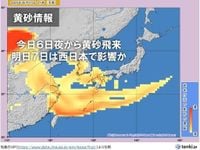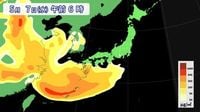From the night of May 6 to May 8, 2025, yellow sand is expected to sweep across western Japan, with significant implications for residents and travelers alike. This phenomenon, known as "黄砂" (Kōsa), originates from the deserts of mainland Asia, particularly the Taklamakan and Gobi deserts, where strong winds lift fine sand particles into the atmosphere. These particles can travel vast distances, often reaching Japan and affecting air quality and visibility.
The earliest arrivals of yellow sand are anticipated in Kumamoto, Miyazaki, and Kagoshima, where it is expected to make its presence felt around 9 PM on May 6. As the night progresses, the yellow sand will continue to spread, affecting regions throughout Kyushu and Okinawa. By the morning of May 7, it will reach the Chugoku and Shikoku regions, and its effects could linger until May 8, 2025.
According to RKB Mainichi Broadcasting, the yellow sand may adhere to laundry dried outdoors, creating a nuisance for households. Moreover, visibility could drop below 5 kilometers, raising concerns about traffic disruptions. Drivers are urged to exercise caution during this period, as poor visibility can lead to dangerous driving conditions.
Health experts have also raised alarms regarding the potential respiratory impacts of yellow sand. Individuals with pre-existing respiratory conditions should take extra precautions. If the yellow sand levels are particularly high, staying indoors may be advisable. The Ministry of the Environment has issued warnings, emphasizing the need for vigilance during this weather phenomenon.
As the yellow sand begins to settle in, residents are advised to take specific measures to mitigate its effects. For instance, it is recommended to wash cars promptly after yellow sand falls to prevent the particles from hardening and becoming more difficult to remove. The best time for car washing is expected to be May 9, when the weather is predicted to improve.
Additionally, households are encouraged to dry laundry indoors during this period, as outdoor drying could lead to yellow sand contamination. Utilizing air purifiers can also help maintain indoor air quality, making it more comfortable for residents.
On the morning of May 6, Okinawa experienced heavy rainfall, with Kumejima reporting an extraordinary 66.0 mm of rain in just one hour. Such conditions can exacerbate the impact of yellow sand, as rain mixed with sand can create muddy deposits that are challenging to clean. As the weather clears on May 7, residents are reminded to remain vigilant about the impending arrival of yellow sand.
As this weather pattern unfolds, the Japanese Meteorological Agency (JMA) will continue to monitor the situation. They have been providing regular updates to keep the public informed about the progression of the yellow sand and its potential impacts. The agency's forecasts indicate that while the weather will improve in some areas, the yellow sand will still pose challenges into the evening of May 7, particularly in Kyushu, Chugoku, and Shikoku.
In summary, the upcoming days will see a significant influx of yellow sand across western Japan, prompting health and safety advisories for residents. The combination of reduced visibility and potential respiratory issues necessitates caution, especially for those with health vulnerabilities. As always, staying informed through reliable weather updates will be crucial for navigating this environmental challenge.





